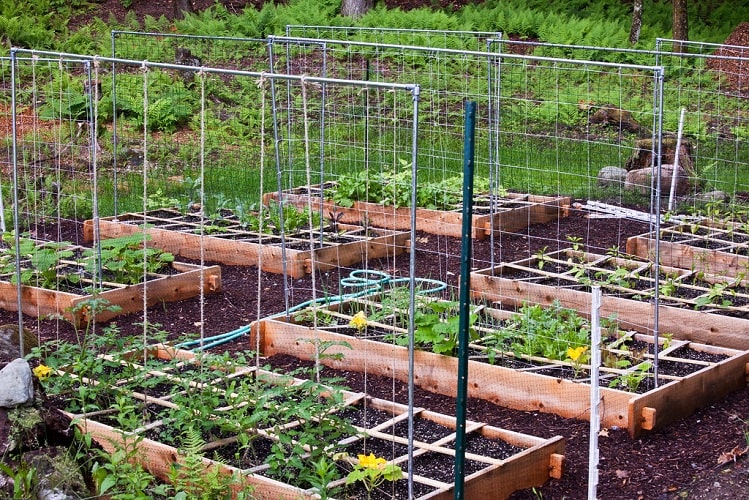Learn the Benefits of Raised Garden Beds

We can’t imagine a better-growing environment than raised garden beds, and the reason for that is no matter.
What type of soil you’re starting with whether it’s nothing or some native soil you can always make it better in a raised bed, now two of the most important things that you’re after for garden success are excellent soil structure and good drainage, and you can easily achieve optimal conditions for both using raised beds.
So let’s talk about the size of the beds first as far as width, you always want the beds to be wide enough, so the roots can spread out as much as they need to go, but you never want the best to be so wide you have to put pressure on the garden soil or step on to it to get into the plant to maintain it, so a good rule of thumb for most people and I are a bed of about four most people and for me is a bed of about four feet wide that’s the perfect width that way I can reach in from either side maintain the plant, and never put pressure, and compact the soil.
So that’s good now as far as the length of the bed it doesn’t matter the plants don’t care:
- What are the matters of your soil in the bed?
- how does it look in your garden?
- what are your budget and personal preference?
Matters of your Garden Soil in the Raised Garden Bed
So what’s with length these happen to be twelve feet long, and it’s perfect in this garden but what does matter is the height of the bed now, We think a minimum height is six inches (06 In) because again you want the roots to be able to grow down, and all plants need at least six inches, but anything above that is gravy now, in this case, these beds are 18 inches tall, maybe that’s a little too much, but not we want these roots to be deprived of their ability to go as deep as they want to go, but eighteen (18) to twelve (12) inches is a happy medium, but if you can help it.
When considering your soil for raised beds it can be brought into the garden, and mounded up in wide rows or added to a frame structure and if you have existing soil, you can simply add more ground beds as needed to fill out the area, but whether you’re starting from scratch or amending an existing bed ideally.
It’s best to incorporate plenty of organic materials such as a wall, aids manure, compost, and even store-bought soil amendments, that way you’re in gently improving the quality of the garden soil, and adding slow-release nutrients for an extra boost, you might want to add a supplemental slow-release organic granular fertilizer.
- The end goal is to create a deep wide growing area that encourages roots to grow down, and out with ground beds that have a good structure.
- an easy test for knowing if you’ve achieved, the ideal mix is when you squeeze the soil in your hand, it binds together yet it crumbles apart easily.
- when disturbed an equally important benefit to just-right soils, and raised garden beds is superb drainage, thanks to gravity water wants always run somewhere.
- The saturated soil in rotted roots is rarely a problem because the water is moving through, and out of the bed.
Fortunately, raised garden beds allow you to easily create the optimal combination of good drainage and moisture retention at the same time by adding lots of organic matter.
Read More: How to Build Raised Garden Beds for Vegetables
The Material of Raised Gardens Bed
Finally, when it comes to the material that you use to make your qualified Raised Garden Beds you have several options, and three of the most common are pressure-treated lumber, it holds up well to the elements and is inexpensive, but some people still have an issue with the fact that they’re chemicals used to treat the wood, although that’s not nearly as much of an issue at this time as it used to be.
We like untreated wood for example No Treated Cedar, it’s super sturdy it holds up well to the elements, and there are no chemicals.
Then a newer option that’s becoming more popular or composite materials, whether it is a resin base or some sort of wood fiber a lot of times they’re guaranteed for life.
Just one more of many options, but whether you choose to contain your soil in a physical barrier or just mound it up wide enough, and deep enough creating that raised bed environment is the best thing that you can do, to get your plants off to a great start, and assure their growing viability throughout the year, because doing two important things you’ve improved the soil structure, and you’ve given that area great drainage, and qualified Raised Garden Beds are a great way to do that.
More Advantages of Raised Vegetable Gardens
Thanks to an increased awareness of our health, the foods we eat have come front and center in most conversations about staying healthy. And while it’s obvious that cutting out things like sugary drinks and greasy foods is important, the idea of eating locally grown foods has never been better. There’s nothing more local than food grown right in your backyard. There are plenty of ways to go about getting great results from your garden, but those who have tried out raised vegetable gardens enjoy a lot of benefits that make it a much better option.
Several things make raised bed vegetable gardens a better option.
- Raised container-type gardening is more attractive. Instead of large patches of your land devoted to becoming a garden, you can use decorative containers that look great and accent your home.
- There’s also less work involved. You don’t have to spend backbreaking days tilling a garden spot, planting, and tending your vegetables. Just fill up a raised bed container with soil and plant. It takes minutes and is much easier to get started.
- Your raised garden will also be easier to manage. Generally, with these gardens, you’ll use a good quality potting mix that won’t contain any weed seeds, which rules out weddings!
- One surprising benefit of raised vegetable gardens is that food may even be able to grow better in them. Potting mix is generally quite friable which makes it easy for your plants to spread their roots and find the nutrients you regularly add by the way of fertilizer. This goes for tomatoes, peppers, and any other type of vegetable you could grow. You’ll often get bigger produce with less work.
- Most qualified Raised Garden Beds can be moved, too. Instead of having to plant and deal with the location for the season, you can easily move your garden if you need to perform lawn work, clean a patio, or handle any other needs that may arise.
- Finally, your raised garden will usually be closer to your kitchen. Instead of having to trek out into the far edges of your property to access a garden, you can step out of the kitchen door and snag some vegetables on the back porch.
If you’re planning on growing vegetables this season, you should certainly consider the many benefits of raised garden bed for vegetable gardens.
Raised beds make growing vegetables easier in many ways. They help you solve difficult issues with your soil, they aid in controlling pests, they improve the amount of produce you can harvest in an area, they’re great at reducing weeds, and they help conserve water.
Any plants that love well-drained soil can benefit from being grown in raised beds. You don’t have to raise just vegetables. You can also easily grow herbs, fruits, and flowers in raised beds and making your job easier.
Whey Raised Bed Make Vegetable Growing Easier
In raised bed gardening, the soil is usually put into frames that are about three or four feet wide and any length. The soil is generally enriched with compost and is added to a frame made of wood or other material like metal color bond sheeting.
The plants in raised bed gardening can be planted much closer together than the plants in a traditional garden. Raised beds can be used to extend the growing season, making it easier to start seeds outdoors earlier, and grow them later in the season. This is a great way to get even more production out of the area in a season.
If you have soil problems in your garden, you can use raised beds and just bypass your existing soil completely. If you start with completely fresh soil, it doesn’t matter what type of soil you had in your garden, to begin with.
Another great benefit of raised bed gardening is the fact that the gardener doesn’t need to walk on the soil in which the plants are growing. This helps prevent the soil from being packed down, so the roots can grow through the soil more readily and water can penetrate more evenly.
You don’t need to till the soil under a raised bed if you don’t want to. This is very beneficial for people who haven’t got a tiller, or who aren’t physically capable of handling a piece of machinery like this. You don’t even need to set them up over soil, you can establish a raised garden bed on pavers or concrete.
You won’t have to water raised beds as often as you would a traditional garden. The soil in raised beds is improved specifically to hold on to water, by the addition of lots of compost and other organic matter so you can water less often and in smaller quantities. This is great for conserving water and saving money.
Frames can be built on top of plywood bases and then raised to any height. This allows handicapped and elderly people to easily reach their plants to tend to them. For people in wheelchairs, this could be one of the only ways they can garden well.
Diseases and pests are easier to control in raised beds. Since you’re starting with fresh soil, it’s less likely to be contaminated with soil-borne diseases or nematodes that could infect your plants. If your plants did become infected, you could simply dispose of the soil in that bed and start again from scratch.
And pests are easier to control because plants are in a more confined area. This makes it much easier to spot potential problems, and it also makes it easier to get rid of potential problems before they take over your entire garden.
Read More: 10 Beautiful Garden World Centers in Delaware
Read More: Raised Garden Bed Ideas









